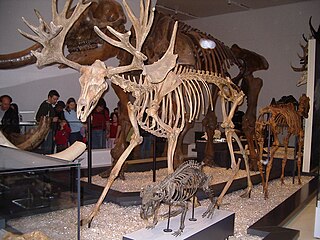Related Research Articles

Phacops is a genus of trilobites in the order Phacopida, family Phacopidae, that lived in Europe, northwestern Africa, North and South America and China from the Late Ordovician until the very end of the Devonian, with a broader time range described from the Late Ordovician. It was a rounded animal, with a globose head and large eyes, and probably fed on detritus. Phacops is often found rolled up ("volvation"), a biological defense mechanism that is widespread among smaller trilobites but further perfected in this genus.

The southern hairy-nosed wombat is one of three extant species of wombats. It is found in scattered areas of semiarid scrub and mallee from the eastern Nullarbor Plain to the New South Wales border area. It is the smallest of all three wombat species. The young often do not survive dry seasons. It is the state animal of South Australia.

Bison latifrons is an extinct species of bison that lived in North America during the Pleistocene epoch ranging from Alaska to Mexico. This species of bison was the largest and heaviest ever to live in North America. B. latifrons thrived in North America for about 200,000 years, but became extinct some 20,000–30,000 years ago, at the beginning of the last glacial maximum.
Dormitator latifrons, the Pacific fat sleeper, is a species of fish in the family Eleotridae found on the Pacific coast of the Americas from around Palos Verdes, California, to Peru, where it can be found in stagnant or sluggish fresh or brackish waters or nearby marine waters. Males of this species can reach a length of 41 cm (16 in), while females grow to 39 cm (15 in). Most do not exceed 25 cm (9.8 in). A maximum weight of 1.2 kg (2.6 lb) has been recorded. This species is important to local commercial fisheries and is actively farmed.
Phrynobatrachus latifrons, the Ahl's river frog or savanna puddle frog, is a species of frog in the family Phrynobatrachidae. It is found from Senegal in West Africa east to northern Cameroon and eastern Chad in western Central Africa. The IUCN Red List includes the following West African countries : Benin, Burkina Faso, Ivory Coast, Gambia, Ghana, Guinea, Liberia, Mali, Nigeria, Senegal, Sierra Leone, and Togo.

The white-fronted falconet, Bornean falconet, is a species of bird of prey in the family Falconidae. It is endemic to Sabah on the island of Borneo. Its natural habitats are subtropical or tropical moist lowland forest and arable land. It is threatened by habitat loss.
Calliphora latifrons is a species of blue bottle fly.
Terpnomyia costalis is a species of ulidiid or picture-winged fly in the genus Terpnomyia of the family Ulidiidae.
Terpnomyia nitens is a species of ulidiid or picture-winged fly in the genus Terpnomyia of the family Ulidiidae.
Terpnomyia is a genus of picture-winged flies in the family Ulidiidae.
Terpnomyia angustifrons is a species of ulidiid or picture-winged fly in the genus Terpnomyia of the family Tephritidae.
Terpnomyia bicolor is a species of ulidiid or picture-winged fly in the genus Terpnomyia of the family Tephritidae.
Terpnomyia citrivitta is a species of ulidiid or picture-winged fly in the genus Terpnomyia of the family Tephritidae.
Terpnomyia tigrina is a species of ulidiid or picture-winged fly in the genus Terpnomyia of the family Tephritidae.

Cervalces latifrons, the broad-fronted moose, was a giant species of moose that inhabited the holarctic regions of Europe and Asia during the Pleistocene epoch. It is believed to be the largest species of deer that ever existed, larger than its North American relative Cervalces scotti, Megaloceros, and the modern moose.

Cervalces is an extinct deer genus that lived during the Pliocene and Pleistocene epochs. Cervalces gallicus, the ancestral species, lived in Europe from the Pliocene to the Pleistocene strata. Cervalces scotti, the stag-moose, lived in Pleistocene North America. Cervalces latifrons, the broad-fronted moose, and Cervalces carnutorum were found in Pleistocene Europe and Asia.

Proetus is a genus of proetid trilobite found in Silurian-aged marine strata of Europe.

Encephalartos latifrons is a species of cycad that is native to Eastern Cape province in South Africa at elevations of 200 and 600 meters.
The Coquito sergeant, also knowns as the Coquito damsel, is a species of ray-finned fish, it is the only species in the monotypic genus Nexilosus which is classified in the family, Pomacentridae, the clownfishes and damselfishes. It is found on rocky coasts in the eastern Pacific Ocean off Peru and northern Chile, as well as the Galapagos Islands.
References
| This article related to members of the insect family Ulidiidae is a stub. You can help Wikipedia by expanding it. |